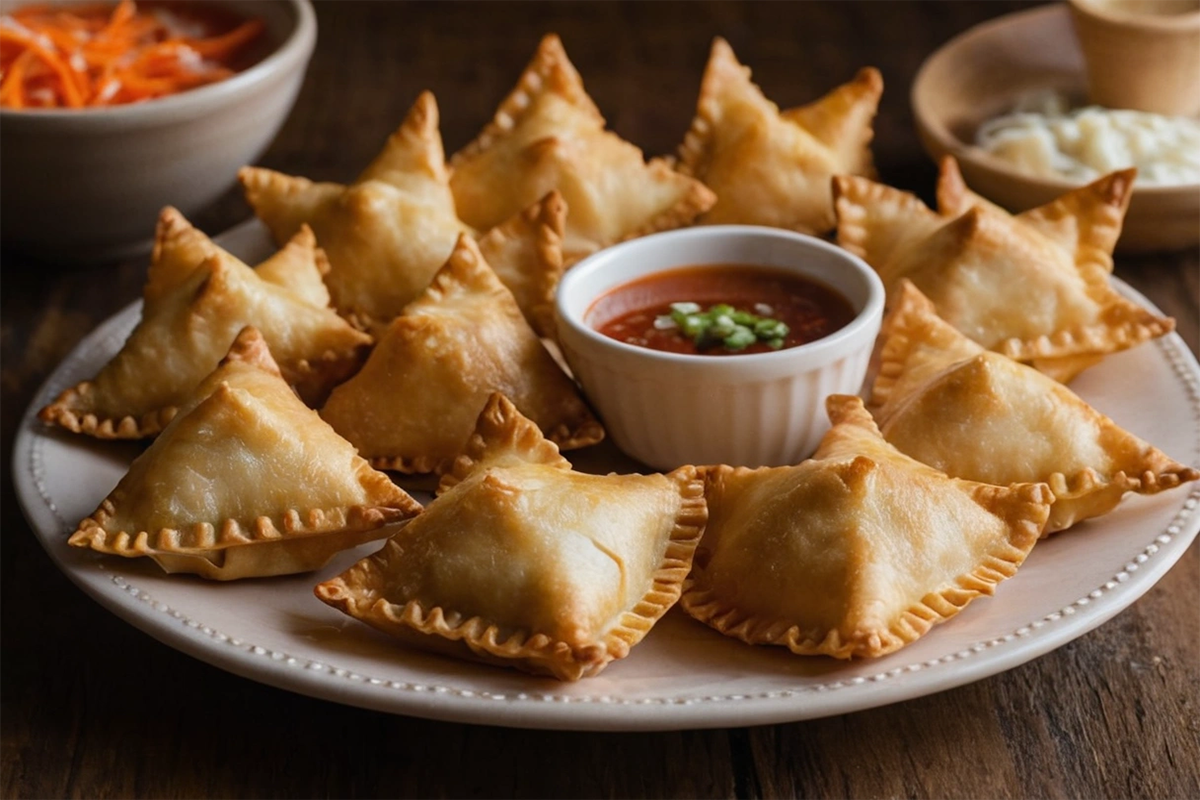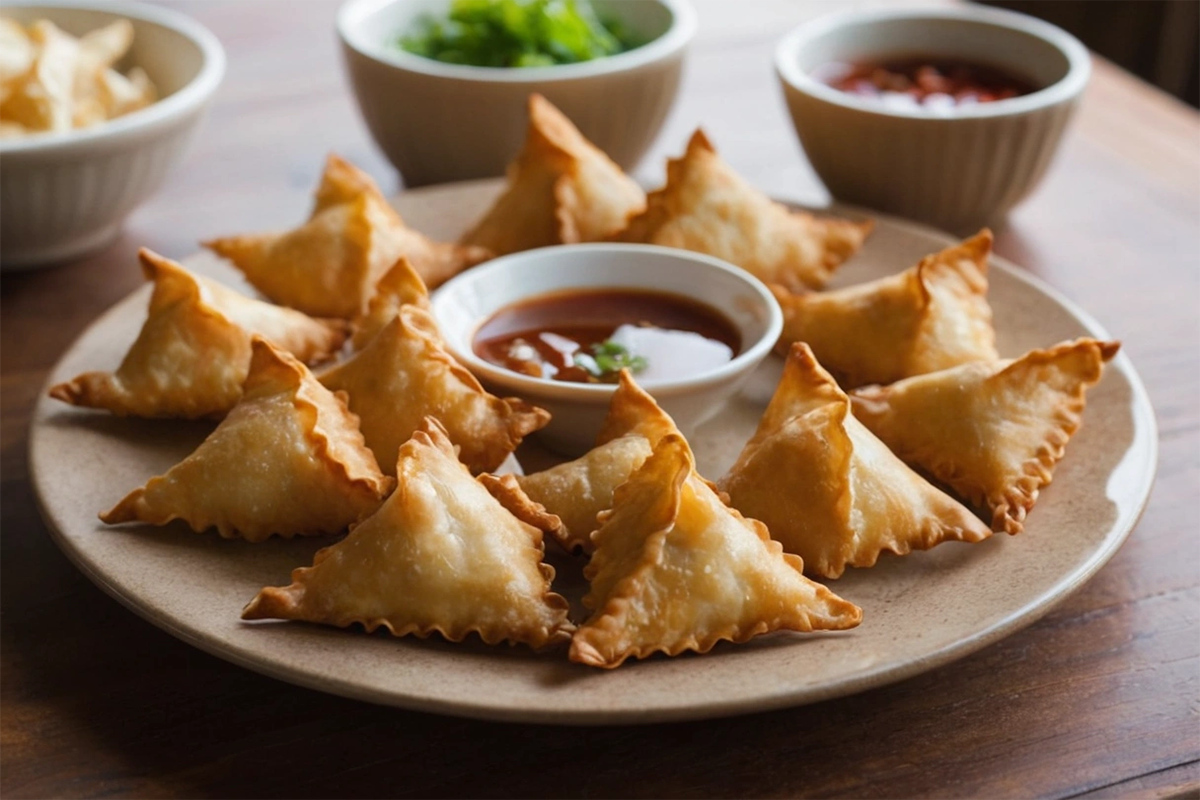rab Rangoon is one of the most beloved appetizers in American Chinese cuisine. Known for its crispy fried exterior and rich, creamy filling, it’s a common sight on Chinese restaurant menus across the United States. But despite its popularity, many wonder, why is it called Crab Rangoon? The answer lies in the fascinating history behind this fusion dish that has captured the hearts and appetites of millions. You can also explore other fusion dishes like Philly Cheesesteak Tortellini Pasta or even a variation of this concept with Crab Rangoon Egg Rolls.
In this article, we’ll explore the origins of this popular appetizer, how it got its unique name, its place in American Chinese cuisine, and the variations and cultural impact it has had since the 1950s. Let’s dive into the world of this beloved dish and unravel its captivating story.
The Origins of Crab Rangoon
This dish’s origin story begins not in China or Burma (modern-day Myanmar), but in the United States. Victor Bergeron, the founder of Trader Vic’s, a renowned Polynesian-themed restaurant chain in California during the 1950s, likely developed this appetizer. Known for his experimental dishes, Bergeron, or possibly his chef Joe Young, combined wonton wrappers with a filling of cream cheese and crab meat. This new creation, deep-fried to perfection, became a hit among diners.
This fried creation became an instant success at Trader Vic’s, thanks to the growing popularity of Polynesian and exotic-themed restaurants in mid-20th century America. Tiki bars and Polynesian-inspired food trends were flourishing, and This appetizer fit perfectly into the fusion-driven culinary era. As tiki culture gained popularity, so did this fried, creamy appetizer.
Why Is It Called “Crab Rangoon”?
The name ‘Crab Rangoon’ combines two elements that don’t typically belong together: crab and Rangoon, now known as Yangon, the capital city of Myanmar. Interestingly, the dish itself has no known ties to Burmese cuisine or any Southeast Asian culinary tradition. The use of “Rangoon” in the name is more a marketing strategy than an indicator of its origin. Chefs designed the dish to evoke exotic and faraway lands, appealing to American diners during the tiki craze of the 1950s.
“Rangoon” added an air of mystery and excitement, while the use of crab (or imitation crab in many cases) gave the dish its signature taste. Chinese wontons inspired this creation, but it features a distinctly American twist, making it a quintessential part of Chinese-American cuisine.
The Popularity of Tiki Culture in the 1950s
Tiki culture gained significant traction in the 1940s and 1950s, especially in post-World War II America. As soldiers returned from the Pacific, a fascination with tropical islands, Polynesian culture, and exotic food took hold. Restaurants like Trader Vic’s and Don the Beachcomber capitalized on this trend, offering elaborate cocktails and fusion dishes that blended tropical flavors with familiar ingredients.Crab Rangoon perfectly fit this trend, offering diners a new and exciting taste experience that felt both familiar and adventurous.
Crab Rangoon’s deep-fried exterior, creamy interior, and touch of seafood made it an instant hit among American consumers, particularly because it played into the allure of exoticism that characterized tiki culture. Trader Vic’s and other similar restaurants became known for their Polynesian-inspired décor, rum-based cocktails, and “exotic” foods like Crab Rangoon, which was neither Polynesian nor Chinese, but a blend of culinary influences meant to entice the American palate.
The Ingredients of Crab Rangoon
At the core of Crab Rangoon are a few essential ingredients that create its distinctive flavor and texture. Let’s break them down:
- Wonton Wrappers: Thin, delicate sheets of dough, wonton wrappers are a staple in Chinese cooking. They provide the crispy, crunchy exterior when fried. Traditionally used in wonton soup or dumplings, these wrappers are deep-fried for Crab Rangoon, giving the dish its signature crunch.
- Cream Cheese: While cream cheese is not traditionally used in Chinese cuisine, its rich, creamy texture resonates with American palates. Cream cheese serves as the main base of the filling, contributing to the indulgent and satisfying texture that diners love.
- Crab Meat or Imitation Crab: Originally made with real crab, many modern versions use imitation crab to reduce costs while maintaining the seafood flavor. This is a key ingredient in Crab Rangoon, offering a slight sweetness and depth of flavor.
- Seasonings: Salt, sugar, garlic, and green onions are commonly added for additional flavor. Some variations may include a splash of Worcestershire sauce or soy sauce for a subtle umami flavor.
Real Crab vs. Imitation Crab
While authentic Crab Rangoon originally included real crab, many restaurants today use imitation crab due to its affordability and accessibility. Imitation crab, also known as surimi, is made from white fish like pollock, mixed with starch and flavoring to mimic the texture and taste of real crab. The cost savings make imitation crab an attractive option for restaurants, though higher-end versions of the dish may still use real crab meat.
Explore more about imitation crab and its uses, which is now a common substitute in Crab Rangoons to cut down on costs.
The Rise of Crab Rangoon in Chinese-American Cuisine
The dish’s appeal was clear. Its fusion of American comfort food (cream cheese) and Asian techniques (fried wonton wrappers) made it a hit with diners. As a result, this dish became a permanent fixture in Chinese-American cuisine, offered alongside egg rolls, fried rice, and other crowd-pleasing favorites.
Why Is Crab Rangoon So Popular?
Crab Rangoon’s popularity can be attributed to several factors:
- Crispy Exterior, Creamy Interior: The combination of textures makes every bite a delight, with the crispy wonton shell providing a satisfying contrast to the rich, creamy filling.
- American Flavors: The use of cream cheese appeals to American palates, adding richness and indulgence to this appetizer.
- Easy to Share: Like many appetizers, Crab Rangoon is easy to share and perfect for parties and gatherings.
- Customizable Filling: Restaurants and home cooks alike can play with the filling, adding crab, scallions, or even spicy ingredients like jalapeños for a different twist.
The Evolution of Crab Rangoon
Though its name and ingredients have evolved, this crispy wonton appetizer has remained a consistent favorite. Originally called ‘Rangoon Crab,’ the name eventually changed to this familiar dish as it became easier to pronounce for the American audience.
Today, you’ll find many variations of this dish across the country, with chefs adding their own unique twists to the classic recipe.
Variations of Crab Rangoon
Chefs and home cooks have developed several creative takes on the traditional Crab Rangoon recipe. Some popular variations include:
- Spicy Crab Appetizer: Adding hot sauce or diced jalapeños to the cream cheese mixture for an extra kick of heat.
- Crab Dip: A warm, creamy dip version of the classic appetizer, served with wonton chips for dipping.
- Vegetarian Rangoon: A meatless version that omits the crab and focuses on cream cheese, scallions, and other flavorful fillings.
Crab Rangoon in Modern Culture
In recent years, this popular appetizer has experienced a resurgence in popularity, particularly on social media platforms like TikTok and Instagram. Food influencers and bloggers have introduced a new generation to this classic dish by sharing recipes, videos, and even Crab Rangoon mukbangs (eating shows). As a result, the dish has once again become a trendy and beloved part of American Chinese cuisine.
Crab Rangoon’s versatility and ease of preparation have made it a popular appetizer for home cooks as well. Whether served as part of a Chinese takeout feast or a party platter, this dish continues to charm food lovers with its unique blend of flavors and textures.
Frequently Asked Questions (FAQs)
1. Why Is It Called Crab Rangoon If There’s No Real Crab?
The term “Crab Rangoon” originally referred to the use of real crab in the filling. However, many modern versions use imitation crab due to cost and availability. Despite this, the name stuck and continues to be used across American Chinese restaurants.
2. Is Crab Rangoon Authentic Chinese Food?
No, Crab Rangoon is a product of Chinese-American fusion cuisine. Although the dish incorporates Chinese techniques, such as frying wonton wrappers, it originated in the United States. Traditionally, it does not appear in Chinese or Burmese (formerly Rangoon) cuisine.
3. How Long Has Crab Rangoon Been Around?
Crab Rangoon was created in the 1950s, likely at Trader Vic’s in California. It quickly spread to other tiki bars and Chinese-American restaurants, becoming a beloved appetizer throughout the country.
4. Can I Make Crab Rangoon Without Crab?
Yes, you can make a vegetarian version by using just cream cheese, scallions, and other seasonings. Many variations exist depending on personal preference, and some home cooks even add herbs like chives for extra flavor.
5. Can You Use Pre-made Syrup or Dipping Sauce?
Yes, pre-made sauces such as sweet-and-sour sauce or chili garlic sauce pair well with Crab Rangoon. Many restaurants offer these as dipping sauces, adding a tangy contrast to the creamy filling.
Conclusion
Crab Rangoon is more than just an appetizer; it reflects the fusion of Chinese techniques and American tastes. While its name may not make sense geographically, the dish has cemented its place in American Chinese cuisine for decades. The crispy wonton and creamy, crab-flavored filling continue to evolve, winning over food lovers around the world.
For more detailed information on the history of Chinese-American cuisine, you can read this article on Wikipedia. To explore more about the cultural influence of dishes like Crab Rangoon, check out this discussion on Quora.



